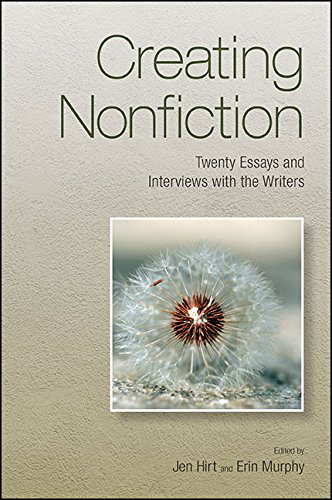Creating Nonfiction
You may have noticed that today’s personal essays are rarely defined by the five-paragraph model—intro, three body paragraphs, conclusion—that is generally taught in English composition classes. What remains standard, though, is the significance of the personal element. Creating Nonfiction: Twenty Essays and Interviews with the Writers exhibits wonderful examples, and the interviews are enough to encourage current and future essayists to keep writing.
You may have noticed that today’s personal essays are rarely defined by the five-paragraph model—intro, three body paragraphs, conclusion—that is generally taught in English composition classes. What remains standard, though, is the significance of the personal element. Creating Nonfiction: Twenty Essays and Interviews with the Writers exhibits wonderful examples, and the interviews are enough to encourage current and future essayists to keep writing.
Kristen Radtke’s “The City of the Century” jumps at readers with strong graphics and text. Deserted buildings in Gary, Indiana; a found photo; the photographer’s fate; and Radtke’s responses shape a dramatic and memorable story. She explains her technique in the interview, downplaying her proficient drawing skills: “So I wrote around them, or showed one small aspect visually and described the rest in the prose. But our own limitations often serve as interesting barriers that can bring us through to something more interesting.”
Gary, Indiana also stars in “Apocalypse, Darling” by Barrie Jean Borich. She and her spouse Linnea attend the wedding of Linnea’s 75-year-old father. The underlying theme is people’s reactions to Borich and Linnea, a lesbian couple:
I look around for Linnea, wondering if her father will ask her to dance next, wondering how that will come off, here at this wedding where half the guests think Linnea is a man. While there must be some wedding some place where grooms dance with their sons, I doubt it happens too often in Northwest Indiana.
Borich answers a question about using real names in essays. “[ . . . ] in the case of family, I’ve long felt renaming them provides distance that allows me to create a literary work [ . . . ] and at the same time gives family members a bit of emotional distance from the unavoidably inaccurate version of them I render for the printed page.”
Dinty W. Moore tackles lawn maintenance uniformity vs. individuality in “Tooth and Claw.” Moore’s lawn apparently isn’t up to snuff according to his neighbor. Moore writes, “Sometimes, though, I will pull into my driveway and experience momentary pangs of shame at the number of little yellow dandelion flowers sprouting on my front lawn. Seldom am I so ashamed that I take action.”
He gives us his take on writing habits: “It is not uncommon for me to work, off and on, for months, on even a very short essay, [ . . . ] I’m guessing most of my published work has gone through thirty to sixty drafts,” showing readers the importance of revision.
Marcia Aldrich takes us step-by-step through “How to Give a Baby a Bath,” a funny piece written in second person. She explains: “The second person is used in guidebooks, self-help books, and do-it-yourself manuals, so it came along for the ride when I decided to write a how-to essay. [ . . . ] The second person allowed me to make a character out of my younger self.”
Fleda Brown chose to compose her essay “My Wobbly Bicycle, 29” from her blog entries. Aimee Nezhukumatathil’s “Birth Geographic” is an 18-point list essay. In the Philippines, she writes,
It is said if a mother is craving sweets and other carbohydrates, the baby will be a girl. It is said if a mother is craving oily or fried foods, the baby will be
a boy.
I only craved sleep, so I thought
for sure I would give birth to a pillow.
It’s certainly worth checking out Erin Murphy’s one-page essay that’s scary and sweet at the same time. She’s one of the book’s editors and teaches at Penn State Altoona. Her advice? “Sentimentality is one of the hardest concepts to explain to beginning writers. My students hear ‘sentiment’ and think ‘feeling,’ which is a good thing, right? I spend a lot of time showing them that it can be as bad as the ‘c-word’ (in this case: ‘cliché’).”
Gaining popularity is the technique Michael Martone uses in “Footnotes & Endnotes.” His title pretty much says it. Scant actual text and a whole bunch of notes. According to Martone:
“I am surprised more of us don’t do it more often now that we have such effortless technology in the computer to create footnotes, endnotes, notes of notes.”
Obviously, the essay genre has become wide open as illustrated in this anthology. Read Creating Nonfiction: Twenty Essays and Interviews with the Writers to savor the essays or to absorb methods and motivations from award winning and widely published writers. You might even create your own absolutely original essay style.





